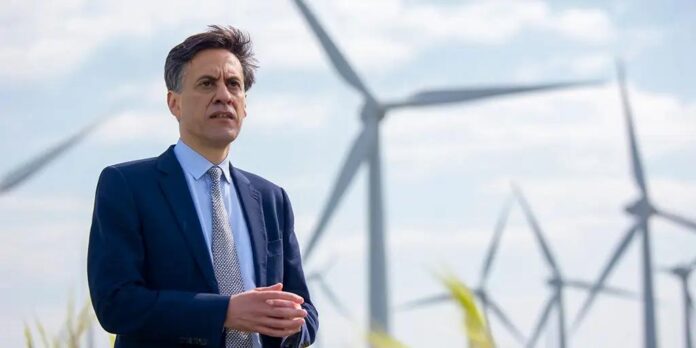At first sight the news that the British Government is reducing forecasts for the amount of energy produced by wind turbines is another nail in the coffin of Net Zero. The Telegraph reports that as a result of “updated modelling” the predicted efficiency of wind turbines is being reduced by more than a quarter. The sceptical might observe a political game being played ahead of the latest annual round of subsidy handouts for future renewable projects. Andrew Montford of Net Zero Watch describes it as “unbelievably deceptive”. The game is one of bumping up the enormous subsidies needed to achieve the Government’s clean power capacity ambitions by 2030 while leaving it to fellow zealots in the media to explain away the future eye-watering electricity costs. Expect therefore organised climate fearmongering to be ramped up, and the large Parliamentary majority currently enjoyed for the next four years by the Labour Government to be utilised to ensure there is no turning back from the Net Zero fantasy.
How can such a plan possibly fail when you have trusted messengers still claiming wind is nine times cheaper than gas? All hope is surely not lost when Fiona Harvey of the Guardian can write a recent story headlined: ‘Wind power has cut £104 billion from UK energy costs since 2010, study finds.’ It might not be a complete surprise that this veteran Guardian headbanger is reporting on statistical modelling from UCL, an academic institution that hardly covered itself in mathematical glory during the Covid pandemic.
In the real world, of course, the further dismal downplaying of wind power is a nail in the Net Zero coffin. It means much higher electricity bills for UK consumers, further deindustrialisation and loss of currently well-paid jobs, increasing likelihood of blackouts and runaway public finances. Nine times cheaper than gas was a Green Blob-funded Carbon Brief hilarity, so how we laughed when a group of top British energy executives told a recent Parliamentary committee that future electricity prices in Britain would not fall even if the price of gas fell to zero.
Chris Norbury, CEO of E.ON UK, laid it on the line for often deluded Parliamentarians. “If I look at the non-commodity costs – policy costs, network costs – then certainly some of the modelling that we have suggests that you could get to a position by 2030 where if the wholesale price was zero, bills would still be the same as they are today because of the increase in those non-commodity costs.” Simone Rossi, Director of Economics at Octopus Energy, highlighted a lack of budgetary control over policy-driven expenses, an obvious reference to £15 billion of renewable subsidies and expenses loaded straight onto UK electricity bills every year without legislative oversight.
By 2030, the hated gas turbines will be running down with no immediate prospect of replacement, while nuclear will also be in short supply until the opening of Sizewell C. Do Edward Miliband and his band of weird wonks at the Energy Department care? Probably not – if your ultimate political aim is command-and-control of the heights of the economy, what are a few blackouts when an elite-ordered socialist nirvana is the ultimate prize? Is it not time to stop routinely calling him ‘Mad’ Miliband, a dismissive insult from his enemies he probably enjoys and even promotes, and start treating his sinister plot with the serious attention it deserves?
Needless to say, the news that energy from wind turbines is nothing like as powerful and plentiful as originally though has been known for some time. In March 2023, the Daily Sceptic reported on a paper published by the Global Warming Policy Foundation (GWPF) noting that “wind power fails on every count”. Even at the time it was charged that governments are ignoring “overwhelming evidence” of the inadequacies of wind power “and resorting to bluster rather than reasoned analysis”.
Written by Oxford University mathematician and physicist Professor Wade Allison – who is also a researcher at CERN and Fellow of Keble College – the short paper concentrates on working out the sums behind natural fluctuations in wind speed. At 20 mph, calculated Professor Allison, the power produced by a wind turbine was 600 watts per square metre at full efficiency. If only the wind stayed at 20 mph all day and night, power generation would be a lot easier. Alas it does not: if the wind speed drops by half, the power available drops by a factor of eight. Conversely, and almost worse, notes Allison, if the wind speed doubles, the power delivered goes up eight times, and the turbines have to be turned off for their own protection.
Want to know why the Miliband zealots are going hell for leather to connect as much wind capacity as they can at whatever price is necessary? Consider the graph below, published in the GWPF paper.

The brown dashed line shows the installed nominated generating capacity in the EU and UK in 2021. This was 236 GW but the highest daily output was only 103 GW, recorded on March 26th. Most other days it was substantially lower.
Professor Allison was doing the sums a couple of years ago and they are the same today since they were based on physics and freely-available information. “Whichever way you look at it, wind power is inadequate. It is intermittent and unreliable; it is exposed and vulnerable; it is weak with a short life-span,” he concludes.
Chris Morrison is the Daily Sceptic’s Environment Editor. Follow him on X.
Discover more from Watts Up With That?
Subscribe to get the latest posts sent to your email.



